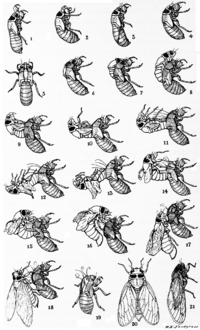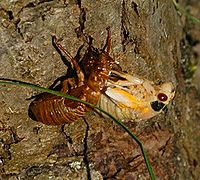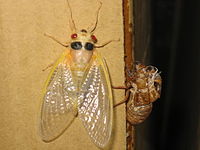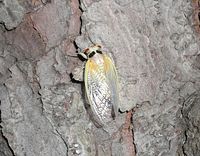- Magicicada
-
Periodical cicada 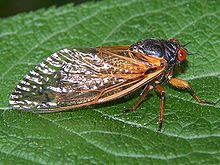
Magicicada sp. from Brood XIII, 2007 Scientific classification Kingdom: Animalia Phylum: Arthropoda Class: Insecta Order: Hemiptera Family: Cicadidae Genus: Magicicada Species See text.
Magicicada is the genus of the 13- and 17-year periodical cicadas of eastern North America. They are sometimes called "17-year locusts", although cicadas belong to order Hemiptera, while locusts are Orthoptera.[1]
Magicicada spp. spend most of their 13- and 17- year lives underground feeding on xylem fluids from the roots of deciduous forest trees on the eastern United States25. After 13 or 17 years, mature cicada nymphs emerge at any given locality, synchronously and in tremendous numbers. After such a prolonged developmental phase, the adults are active for about 4 to 6 weeks26. The males aggregate into chorus centers and attract females for mating. Within two months of the original emergence, the life cycle is complete, the eggs have been laid and the adult cicadas are gone for another 13 or 17 years.
Contents
Description
The familiar winged imago (adult) periodical cicada has red eyes and a black dorsal thorax. The wings are translucent and have orange veins. The underside of the abdomen may be black, orange, or striped with orange and black, depending on the species.[2]
Adults are typically 2.4 to 3.3 cm (0.9 to 1.3 in), depending on species, slightly smaller than the annual cicada species found in the same regions of the United States. Mature females are slightly larger than males.[3]
Magicicada males typically form large aggregations that sing in chorus to attract receptive females. Different species have different characteristic calling songs. The call of decim periodical cicadas is said to resemble someone calling "weeeee-whoa" or "Pharaoh."[4] The cassini and decula periodic cicadas have songs that intersperse buzzing and ticking sounds.[3]
Cicadas do not bite or sting. Like other Hemiptera, they have mouthparts for piercing and sucking sap from plants. The cicada's proboscis can also pierce human skin, which is painful if it occurs but in no other way harmful. They are not venomous, and there is no evidence that they transmit diseases. They pose little threat to mature vegetation, although planting new trees or shrubs is best postponed until after an expected emergence of the periodical cicadas. Mature plants rarely suffer lasting damage, although some twig die-off or flagging may result if egg-laying is heavy.[5]
Life cycle
Nearly all cicadas spend years underground as juveniles, before emerging above ground for a short adult stage of several weeks to a few months. The seven periodical cicada species are so named because, in any one location, all of the members of the population are developmentally synchronized—they emerge as adults all at once in the same year. This periodicity is especially remarkable because their life cycles are so extremely long—13 or 17 years. Cicadas of all other species (perhaps 3000 worldwide) are not synchronized, so some adults mature each summer and emerge while the rest of the population continues to develop underground. Many people refer to these non-periodical species as annual cicadas since some are seen every summer. The life cycles of most annual species range from two to ten years, although some could be longer.
The nymphs of the periodical cicadas live underground, often at depths of 30 cm (1 ft) or more, feeding on the juices of plant roots.[6] The nymphs of the periodical cicada undergo 5 instar stages in their development underground. The difference in the 13 and 17 year life cycle is the time it takes for the second instar to mature. While underground, the nymphs move deeper below ground feeding on larger roots27.
The nymphs emerge on a Spring evening when the soil temperature at about 20 cm (8 in) depth is above 17 °C (63 °F). In most years, this works out to late April or early May in far southern states, and late May to early June in the far northern states. Emerging nymphs climb to a suitable place on the nearby vegetation to complete their transformation into an adult cicada. They molt one last time and then spend about six days in the leaves waiting for their exoskeleton to harden completely. Just after this final molt, the teneral adults are white, but darken within an hour.
Adult periodical cicadas live only for a few weeks—by mid-July, all have disappeared. Their short adult life has one purpose: reproduction. The males "sing" a species-specific mating song; like other cicadas, they produce loud sounds using their tymbals. Singing males of a single Magicicada species form aggregations (choruses) that are sexually attractive to females. Males in these choruses alternate bouts of singing with short flights from tree to tree in search of receptive females.[7] Most matings occur in "chorus" trees.[2]
Receptive females respond to the calls of conspecific males with timed wing-flicks, which attract the males for mating. The sounds of a "chorus"—a group of males—can be deafening and reach 100 dB. In addition to their "calling" or "congregating" song, males produce a distinctive courtship song when approaching an individual female.[2]
Both males and females can mate multiple times, although most females seem to mate just once. After mating, the female cuts V-shaped slits in the bark of young twigs and lays approximately 20 eggs in each, for a total of 600 or more eggs. After about six to ten weeks, the eggs hatch and the newborn nymphs drop to the ground, where they burrow and begin another 13 or 17-year cycle.
Predator satiation survival strategy
The nymphs emerge in large numbers at about the same time, sometimes more than 1.5 million individuals per acre (>370/m²).[8] Their mass-emergence is a survival trait called predator satiation: for the first week after emergence, the periodic cicadas are an easy prey for reptiles, birds, squirrels, cats, and other small and large mammals.[9][10] Early ideas maintained that the cicadas' overall survival mechanism was simply to overwhelm predators by their sheer numbers, ensuring the survival of most of the individuals. It was hypothesized that the emergence period of large prime numbers (13 and 17 years) was a predatory avoidance strategy adopted to eliminate the possibility of potential predators receiving periodic population boosts by synchronizing their own generations to divisors of the cicada emergence period.[11] A more parsimonious viewpoint holds that the prime numbered developmental times represent an adaptation to colder soil temperatures during Pleistocene glacial stadia, and that predator satiation is a short term maintenance strategy.[12] This hypothesis was subsequently supported through a series of mathematical models, and stands as the most widely accepted explanation of the unusually lengthy and mathematically precise immature period of these bizarre insects.[13] The length of the cycle appears to be controlled by a single gene locus, with the 13-year cycle dominant to the 17-year one.[14]
Impact on other populations
Cycles in cicada populations are significant enough to affect other animal and plant populations. For example, tree growth has been observed to decline the year before the emergence of a brood because of the increased feeding on roots by nymphs.[15] Moles, which feed on nymphs, have been observed to do well during the year before an emergence, but suffer population declines the following year because of the reduced food source.[16] Wild turkey populations respond favorably to increased nutrition in their food supply from gorging on cicada adults on the ground at the end of their life cycle. Uneaten carcasses of periodic cicadas decompose on the ground, providing a resource pulse of nutrients to the forest community.[15]
Cicada broods can also have a negative impact. Squirrel populations have been decimated because the egg laying activity of female cicada damaged upcoming mast crops.[citation needed]
Broods
Periodical cicadas are grouped into broods based on the calendar year when they emerge.
In 1907, entomologist C. L. Marlatt assigned Roman numerals to 30 different broods of periodical cicadas: 17 distinct broods with a 17-year life cycle, to which he assigned brood numbers I through XVII (with emerging years 1893 through 1909); plus 13 broods with a 13-year cycle, to which he assigned brood numbers XVIII through XXX (1893 through 1905).[17]
Many of these hypothetical 30 broods, however, have not been observed. Furthermore, two of the brood numbers assigned by Marlatt (Broods XI and XXI) existed at one time but have become extinct. The Marlatt numbering scheme has been retained for convenience, although today only 15 broods survive. [18]
Name Nickname Cycle (yrs) Last emergence Next emergence Extent Brood I The Blue Ridge Brood 17 1995 2012 Western VA, WV Brood II The East Coast Brood 17 1996 2013 CT, MD, NC, NJ, NY, PA, VA Brood III The Iowan Brood 17 1997 2014 IA Brood IV The Kansan Brood 17 1998 2015 KS, MO, OK Brood V none 17 1999 2016 Northeast OH, MD, PA, VA, WV Brood VI none 17 2000 2017 GA, NC, SC Brood VII The Onondaga Brood 17 2001 2018 Upstate NY1 Brood VIII none 17 2002 2019 OH, PA, WV Brood IX none 17 2003 2020 Western VA, WV, NC Brood X The Great Eastern Brood 17 2004 2021 From NY to NC along the East Coast, inland to IL and MI2 Brood XI none 17 (2005) Extinct Last seen in 1954 in Ashford, CT along Fenton River Brood XIII The Northern Illinois Brood 17 2007 2024 Northern IL and in parts of IA, WI, and IN3 Brood XIV none 17 2008 2025 Southern OH, KY, TN, MA, MD, NC, PA, northern GA, Western VA and WV, and parts of NY and NJ3 Brood XIX The Great Southern Brood 13 2011 2024 AL, AR, GA, IN, IL, KY, LA, MD, MO, MS, NC, OK, SC, TN, and VA4 Brood XXI The Floridian Brood 13 (2000) Extinct Last recorded in 1870. Historical range included the FL panhandle Brood XXII The Baton Rouge Brood[19] 13 2001 2014 LA, MS, OH, KY 5 Brood XXIII The Lower Mississippi River Valley Brood 13 2002 2015 IA, IL, IN, WI 1. Consists only of M. septendecim.
2. Largest of all 17-year periodical broods.
3. Premature emergences, or "straggling" occurred in 2003 and 2006.[20]
4. Largest of all 13-year periodical cicada broods.
5. This 13-year brood does not include M. neotredecim.Taxonomy
There are seven recognized species. Three species have a 17-year cycle:
- Magicicada septendecim (Linnaeus, 1758)
- Magicicada septencassini (also called Magicicada cassini) (Fisher 1851)
- Magicicada septendecula(Alexander and Moore, 1962)
Four more species follow a 13-year cycle:
- Magicicada neotredecim (Marshall and Cooley, 2000)
- Magicicada tredecim (Walsh and Riley, 1868)
- Magicicada tredecassini (Alexander and Moore, 1962)
- Magicicada tredecula (Alexander and Moore, 1962)
These seven species are also sometimes grouped differently into three subgroups, the so-called "-decim species," "-cassini species," and -decula species," reflecting strong similarities of each 17-year species with one or more species with a 13-year cycle.[21]
Generally, the 17-year cicadas are distributed more in the northern states of the eastern United States, while the 13-year cicadas occur in the southern states, but some may overlap, for example, brood IV (17 year cycle) and XIX (13 year cycle) in western Missouri.[22][23] If this distribution holds, their emergence will coincide in—2219, 2440, 2661, etc., as it did in 1998[24] (although distributions change slightly from year to year and distribution maps can be unreliable, especially older maps.[23]).
Media
Hundreds of cicadas, Brood X
(View in high quality)References
- ^ "Periodical Cicada". University of Michigan. http://insects.ummz.lsa.umich.edu/fauna/
- ^ a b c Alexander, Richard D; Thomas E. Moore (1962). "Error: no
|title=specified when using {{Cite web}}". U Michigan Museum of Zoology. http://entnemdept.ufl.edu/walker/buzz/c700lam62.pdf. Retrieved 9 June 2011. - ^ a b Capinera, John L. (2008). Encyclopedia of Entomology. Springer. pp. 2785–2794. ISBN 1402062427. http://books.google.com/books?id=i9ITMiiohVQC.
- ^ Stranahan, Nancy. "Nature Notes from the Eastern Forest". Arc of Appalachia. http://www.highlandssanctuary.org/nature.notes.1.cicada/nature.notes.htm. Retrieved 10 June 2011.
- ^ Cook, William M.; Robert D. Holt (2002). "Periodical Cicada (Magicicada cassini) Oviposition Damage: Visually Impressive yet Dynamically Irrelevant". American Midland Naturalist 147 (2): 214–224. doi:10.1674/0003-0031(2002)147[0214:PCMCOD]2.0.CO;2. http://people.biology.ufl.edu/rdholt/holtpublications/119.pdf. Retrieved 18 June 2011.
- ^ Marlatt, C. F. (1907). "The periodical cicada". Bulletin of the USDA Bureau of Entomology 71 (1): 1–181
- ^ "Magicicada Brood XIX is emerging now". National Geographic Society. http://hydrodictyon.eeb.uconn.edu/projects/cicada/magicicada_central/magicicada_central.php. Retrieved 13 June 2011.
- ^ Dybas, H. S.; Davis, D. D. (1962). "A populations census of seventeen-year periodical cicadas (Homoptera: Cicadidae: Magicicada)". Ecology 43 (3): 432–444. doi:10.2307/1933372. JSTOR 1933372
- ^ Williams, K. S.; Smith, K. G.; Stephen, F. M. (1993). "Emergence of 13-year periodical cicadas (Cicadidae, Magicicada): phenology, mortality, and predator satiation". Ecology 74 (4): 1143–1152. doi:10.2307/1940484. JSTOR 1940484
- ^ Williams, K. S.; Simon, C. (1995). "The ecology, behavior and evolution of periodical cicadas". Annual Review of Entomology 40: 269–295. doi:10.1146/annurev.en.40.010195.001413
- ^ Goles, E.; Schulz, O.; Markus, M. (2001). "Prime number selection of cycles in a predator-prey model". Complexity 6 (4): 33–38. doi:10.1002/cplx.1040
- ^ Cox, R. T., and C. E. Carlton. Paleoclimatic influences in the evolution of periodical cicadas (Homoptera: Cicadidae: Magicicada spp.). American Midland Naturalist 120: 183-193
- ^ Tanakaa, Y, J. Yoshimura, C. Simone, J. Cooley, and K. Tainakab. Allee effect in the selection for prime-numbered cycles in periodical cicadas. Proceedings of the National Academy of Sciences 106: 8975-8979
- ^ Cox, R. T., and C. E. Carlton. Evidence for genetic dominance in 13-year periodical cicadas (Homoptera: Cicadidae: Magicicada spp.). American Midland Naturalist 125: 63-74.
- ^ a b Yang, Louie H. (2004). "Periodical cicadas as resource pulses in North American forests". Science 306 (5701): 1565–1567. doi:10.1126/science.1103114. PMID 15567865
- ^ National Geographic: Cicada Outbreaks Linked to Other Animals' Booms, Busts.
- ^ Marlatt, C.L. (1907). The Periodical Cicada. USDA. p. 28. http://books.google.com/books?id=CloDAAAAYAAJ.
- ^ Post, Susan L. (2004). "A Trill of a Lifetime". The Illinois Steward. http://www.inhs.uiuc.edu/highlights/periodicalCicada.html. Retrieved 9 June 2011.
- ^ "Brood XXII (13-year) The Baton Rouge Brood". National Geographic Society. http://www.magicicada.org/about/brood_pages/broodXXII.php. Retrieved 28 August 2011.
- ^ (Associated Press) "Swarms of cicadas emerging in Midwest" 20 May 2007
- ^ "Magicicada species". National Geographic Society. http://www.magicicada.org/about/species_pages/species.php. Retrieved 12 June 2011.
- ^ Compare brood IV distribution with [ brood XIX distribution]. From University of Michigan, Zoology, Insect division [1]
- ^ a b See figure 1, p. 107, Cooley et al. [The distribution of periodical cicadas. http://www.magicicada.org/cooley/reprints/Cooley_ea_2009.pdf] American Etymologist, 55:2, 106-112.
- ^ Lifecycles Of Cicada Species Are Focus Of Biologist's Research, The UConn Advance, 4/26/2004, Elizabeth Omara-Otunnu
25. Lloyd, M., and H.S. Dybas. 1966a. The periodical cicada problem. I. Population ecology.Evolution 20(2):133-149.
26. Williams, K.S., and C. Simon. 1995. The ecology,, behavior, and evolution of periodical cicadas. Annual Review of Entomology 40:269-295.
27. White, J, and M. Lloyd. 1979. Seventeen year cicadas emerging after eighteen years-a new brood? Evolution 33:1193-1199.
External links
- Massachusetts Cicadas describes behavior, sightings, photos, "how to find" guide, videos and distribution maps of New England and U.S. periodical and annual cicada species including Brood X, Brood XIII, Brood XIV and Brood XIX
- Magicicada.org Brood XIX mapping project – solicits records and observations from the general public
- Cicada Mania
- Comprehensive website with reprints, distribution records, databases, and maps at Cicada Central.
- Comprehensive web site University of Michigan
- Bibliography
- Link list
- Image gallery
- Roar of the Cicada
- InsectSingers.com Recordings of species-specific songs of many North American cicada species.
- magicicada.com The oddest recordings of North American cicada species
Periodic cicada broods Brood I • Brood II • Brood III • Brood IV • Brood V • Brood VI • Brood VII • Brood VIII • Brood IX • Brood X • Brood XIII • Brood XIV • Brood XIX • Brood XXII • Brood XXIIICategories:- Cicadas
- Periodic phenomena
Wikimedia Foundation. 2010.

